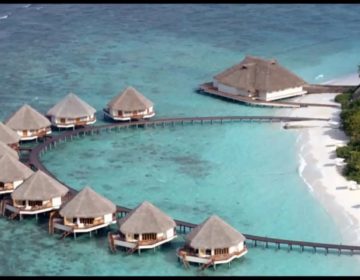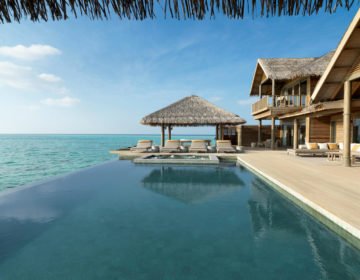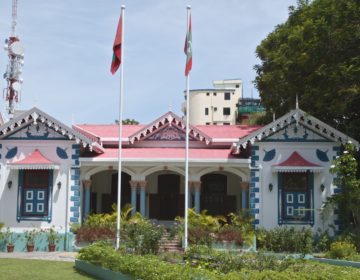Tourism is the most important economic industry in the Maldives and plays a vital role in earning foreign exchange revenue and generating employment in the tertiary sector of the country. The warm climate of the Maldives, exquisite white sandy beaches and incredible underwater marine life are the primary sources of attraction to many tourists visiting the country, along with recreational pursuits such as scuba diving, snorkeling, and surfing.
 Photo credit: CNN.com
Photo credit: CNN.com
In a United Nations mission on development that came to the Maldives in the 1960s said that these islands are not suitable for tourism. However, the Maldives proved otherwise, and tourism continues to flourish ever since the first resort opened in 1972.
At that time, there were no foreign investments. The remote archipelago, inhabited mainly by fishermen, was not well known to the outside world. At that time there were only two airstrips in the country. One was on Hulhule Island (the present Velana International Airport), built by local volunteers, and one on Gan Island in Addu Atoll built by the British air force, but there were no regular flights.
 Velana International Airport (once Hulhule Airport)
Velana International Airport (once Hulhule Airport)
Mohamed Umaru Maniku, a pioneer of the local tourism industry, recalled, “we had nothing in the Maldives then. No banks, no airport, no telephones, and only hand radios or Morse code contact with Colombo. Even the UNDP experts said that tourism would never succeed because there were no facilities and no infrastructure.”
The tourism in the Maldives flourished with the passion, determination and hard work of its young and energetic Maldivian founders. The story of Maldivian tourism begins with a meeting in Colombo between George Corbin, an Italian travel agent and Ahmed ‘Kerafa’ Naseem, then a staff member in the Maldivian embassy in Sri Lanka who later became Foreign Minister of the Maldives. At that time, Corbin was seeking uninhabited islands where he could bring Italians to swim and hunt fish. On his first visit to Malé, with Naseem by a cargo ship in 1971, Corbin fell in love with the Maldives at first sight and left the country only to return with more tourists.
In February 1972 the first group of tourists, mainly journalists and photographers came with Corbin. They stayed in three very ordinary houses in Malé. They were looked after by Mr. Maniku and his friends, including Hussain ‘Champa’ Afeef, another pioneer of the industry. They thought the Maldives was perfect for swimming, sunbathing, and fishing. Corbin told Maniku, Naseem and Afeef that he will bring more tourism if they can arrange an appropriate place for tourists to stay.

Maniku and Afeef chose Vihamanaafushi, then an uninhabited island coconut plantation, where the President of the then British Protectorate Maldives is buried. They took the island for its closeness to the airstrip and the capital. Traveling between the island, the airstrip and the capital city was on a sailing dhoni or an open boat with an outboard motor. There was no proper jetty (although one was later built using coconut trunks as pillars). After arriving by boat on the beach, tourists had to walk through the surf to reach the resort.

MU Maniku, then an agricultural officer, spent his time after work finishing each day at 1:30 pm to develop Vihamanaafushi to be the first resort in the Maldives. Maniku and his young Maldivian friends built 30 rooms in blocks of three, using coral stone for walls, coconut timber, and palm thatch for roofs, initially with financial help from Corbin. Each room had a brackish water shower and toilet, basic furniture, and access to the beach. Meals were provided in a canteen or as barbecues on the beach.

They called the resort Kurumba Village after the Dhivehi word for young coconut, Kurumba. Afeef was the first manager of the newly opened resort. Kurumba Village was opened on Tuesday 3rd October 1972 and remained fully booked for the rest of the year.
 Kurumba Village. Photo credit: Kurumba Village Resort
Kurumba Village. Photo credit: Kurumba Village Resort
“We knew nothing about tourism,” said Mohamad Umaru Maniku. “It was tourists who helped us build the industry here. We listened to them and gave them what they wanted. Luckily for us, they wanted simplicity in natural surroundings, and that was what had to offer and all we could afford.”
“In the beginning, we didn’t know what to cook for these tourists from overseas, or how to deal with them. I had a recipe book in English which I translated into Dhivehi so the boys could understand. I was cook, gardener and room boy. We had to do everything ourselves,” he said. Kurumba Village is the first resort that was opened in the Maldives, followed by Bandos Resort.
Tourism in the Maldives started with just two resorts with a capacity of around 280 beds and now has more than 130 operational resorts.
The unique condition of the Maldives is that one island is one resort, meaning that one hotel occupies a whole island. A tourist resort in the Maldives typically consists of an exclusive hotel on its own island, with its population entirely made up of tourists and the staff of the hotel with no local inhabitants. This model provides more privacy and exclusiveness for tourists.
 Lily Beach Resort & Spa
Lily Beach Resort & Spa
Those islands developed for tourism are typically 800 and 200 meters in size and are composed of sand and coral to a maximum height of about two meters above the sea. In addition to its beach encircling the island, each island has its own ‘house reef’ which serves as a coral garden and natural aquarium for scuba divers and snorkelers. The shallow water enclosed by the house reef also serves as a large natural swimming pool and protects swimmers from the ocean waves and strong tidal currents outside the house reef.
 Kuredu House Reef
Kuredu House Reef
The buildings on a typical Maldivian resort include rooms and suites reserved for use by its guests, restaurants, coffee shops, gift shops, bars, lounges, discos and diving schools. A portion of the island also contains staff lodgings and support services such as catering, power generators, laundry, and a sewerage point. There are also shops on these resort islands that offer a wide range of products, such as souvenirs and artifacts. Most resorts offer a wide variety of activities such as aerobics, volleyball, football and table tennis.
Over the decades, the number of tourists in the Maldives has continuously risen. In 2009, local island guesthouses started growing in the Maldives as a result of a change in the regulations that began to officially allow tourists to stay among the local population, rather than just privately-owned resort islands. In 2017, a total of 1.3 million tourists visited the Maldives.
(Source: Maldive Islands, January 2019, Issue 11)



